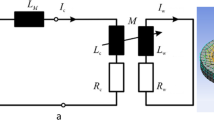Abstract
The increasing need for lightweight building components has led to the development of new methods to manufacture such components. A promising concept is the systematic application of high-speed metal forming methods. Electromagnetic forming is one such method. Here, the deformation of the workpiece is driven by the Lorentz force which results from the interaction of a current generated in the workpiece with a magnetic field generated by a coil adjacent to the workpiece. This force represents an additional volume- or body-force density contribution in the balance of linear momentum. The numerical treatment of the coupled set of partial differential equations for the mechanical and electromagnetic fields can be made more efficient from the computational point of view by using the finite element technology suggested here, which is based on reduced integration and hourglass stabilisation. The main idea behind this new technology is to expand the constitutive quantities in a Taylor expansion with respect to a point on the local coordinate axis in the thickness direction. The result is a weak system of equations which decomposes into a part to be evaluated in two Gauss points and in addition the so-called hourglass stabilisation to be computed analytically.
Similar content being viewed by others
References
Takata, N., Kato, M., Sato, K., Tobe, T.: High-speed forming of metal sheets by electromagnetic forces. Japan Soc Mech Eng Int J 31, 142 (1988)
Fenton, G., Daehn, G.S.: Modeling of electromagnetically formed sheet metal. J Mat Process Tech 75, 6–16 (1998)
Kleiner, M., Brosius, A., Blum, H., Suttmeier, F.T., Stiemer, M., Svendsen, B., Unger, J., Reese, S.: Benchmark simulation for coupled electromagnetic-mechanical metal forming processes. WGP–-Production Engineering, Hauser-Verlag, München (2004)
Reese, S.: On a consistent hourglass stabilization technique to treat large inelastic deformations and thermomechanical coupling in plane strain problems. Int J Num Meth Eng 57, 1095–1127 (2003)
Reese, S.: A large deformation solid-shell concept based on reduced integration with hourglass stabilization. Int J Num Meth Eng (2005)
Simo, J.C., Armero, F.: Geometrically nonlinear enhanced strain mixed methods and the method of incompatible modes. Int J Num Meth Eng 33, 1413–1449 (1992)
Simo, J.C., Armero, F., Taylor, R.L.: Improved versions of assumed enhanced strain tri-linear elements for 3D finite deformation problems. Comput Methods Appl Mech Eng 110, 359–386 (1993)
Cao, Y.P., Hu, N., Lu, J., Fukunaga, H., Yao, Z.H.: A 3D brick element based on Hu-Washizu variational principle for mesh distortion. Int J Num Meth Eng 53, 2529–2548 (2002)
Areias, P.M.A., César de Sá, J.M.A., Conceicao António C.A., Fernandes, A.A.: Analysis of 3D problems using a new enhanced strain hexahedral element. Int J Num Meth Eng 58, 1637–1682 (2003)
Belytschko, T., Bindeman, L.P.: Assumed strain stabilization of the eight node hexahedral element. Comput Methods Appl Mech Eng 105, 225–260 (1993)
Liu, W.K., Guo, Y., Tang, S., Belytschko, T.: A multiple-quadrature eight-node hexahedral finite element for large deformation elastoplastic analysis. Comput Methods Appl Mech Eng 154, 69–132 (1998)
Puso, M.A.: A highly efficient enhanced assumed strain physically stabilized hexahedral element. Int J Num Meth Eng 49, 1029–1064 (2000)
Reese, S., Wriggers, P., Reddy, B.D.: A new locking-free brick element technique for large deformation problems in elasticity. Comput Struct 75, 291–304 (2000)
Cardoso, R.P.R., Yoon, J.-W., Grácio, J.J., Barlat, F., César de Sá, J.M.A.: Development of a one point quadrature shell element for nonlinear applications with contact and anisotropy. Comput Methods Appl Mech Eng 191, 5177–5206 (2002)
Legay, A., Combescure, A.: Elastoplastic stability analysis of shells using the physically stabilized finite element SHB8PS. Int J Num Meth Eng 57, 1299–1322 (2003)
Reese, S.: On a physically stabilized one point finite element formulation for three-dimensional finite elasto-plasticity. Comput Methods Appl Mech Eng (2005)
Simo, J.C., Hughes, T.J.R.: Computational Inelasticity. Springer series on interdisciplinary applied mathematics 7. Springer, Berlin Heidelberg New York (1998)
Svendsen, B., Chanda, T.: Continuum thermodynamic formulation of models for electromagnetic thermoinelastic solids with application to electromagnetic metal forming. Continuum Mech Thermodyn, (in press) (2005)
Stiemer, M., Unger, J., Svendsen, B., Blum, H.: Algorithmic formulation and numerical implementation of coupled multifield models for electromagnetic metal forming simulations, to be submitted to Int J Numer Methods Eng (2005)
Belytschko, T., Ong, J.S.-J. Ong, Liu, W.K., Kennedy, J.M.: Hourglass control in linear and nonlinear problems. Comput Methods Appl Mech Eng 43, 251–276 (1984)
Eberlein, R.: Finite-Elemente-Konzepte für Schalen mit großen elastischen und plastischen Verzerrungen, PhD Thesis, Department of Mechanics, Darmstadt University of Technology (1997)
Author information
Authors and Affiliations
Corresponding author
Rights and permissions
About this article
Cite this article
Reese, S., Svendsen, B., Stiemer, M. et al. On a new finite element technology for electromagnetic metal forming processes. Arch Appl Mech 74, 834–845 (2005). https://doi.org/10.1007/s00419-005-0389-2
Received:
Accepted:
Published:
Issue Date:
DOI: https://doi.org/10.1007/s00419-005-0389-2




